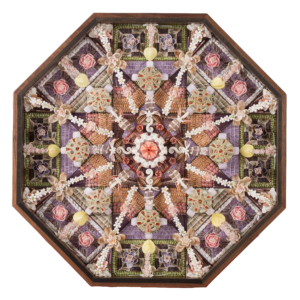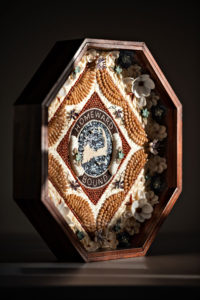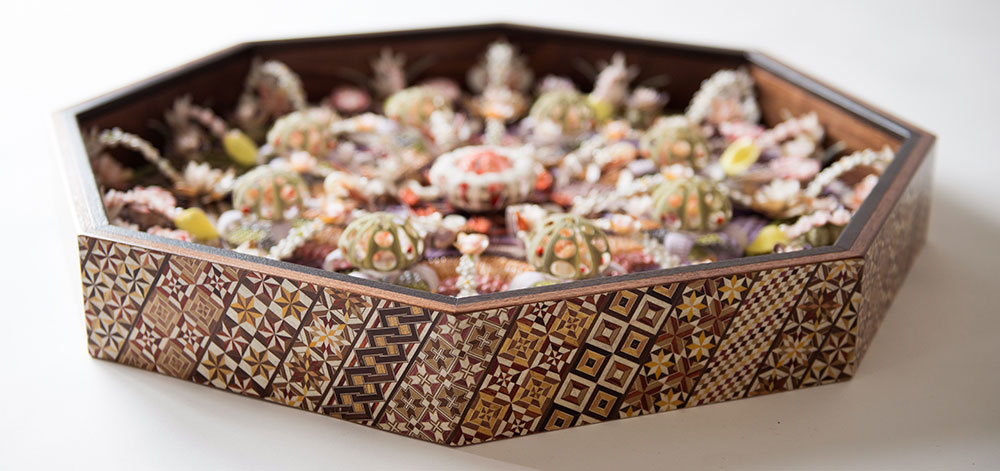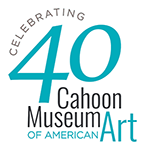
Exquisite Shells: The Art of Sailors Valentines
May 21 – September 1, 2019
This international blockbuster, curated by Cahoon Museum Director Sarah Johnson, PhD, highlights the Sailors Valentine, a unique and intricate art form finely crafted from seashells. The surprising global history of the art form is explained and brought to life through the stories of the makers and owners of antique Sailors Valentines from Barbados to Europe and the United States. New perspectives from exceptional contemporary Sailors Valentine artists detail the evolution of this nineteenth century craft into an art form both uniquely imaginative and exquisitely detailed.
Exhibiting contemporary artists include: Helen Beck, Sandi Blanda, Pam Boden, Martha Cahoon (1905-1999), Ralph Cahoon (1910-1982), Judy Dinnick, Peter Gabel, Margot Goodwin, Hatsue Iimuro, Grace Madeira, Sandy Moran, Elizabeth Mumford, Gerda Reid, Gregg Roberts, Bernard Woodman (1920-1986).
A CURIOUS HISTORY OF AN UNUSUAL ART FORM
Centuries ago, sailors traveled around the globe on long whaling and merchant voyages and brought back treasures gathered from years at sea. In their long, tedious shipboard hours, they carved intricate whalebone objects, known as scrimshaw, and it was thought that they also created elaborate shellwork compositions to offer to wives, sweethearts, sisters, and mothers as homecoming gifts. While sailors did bring shellwork mosaics home from their travels in the 1800s, the objects originated from a cottage industry of makers in Barbados.
 Housed in octagonal wooden boxes, sailors valentines consisted of an array of beautiful shells in intricate arrangements. Their designs incorporated hearts, flowers, and nautical symbols such as anchors or compass roses and sometimes carried a message –Home Again or Forget Me Not– written out in tiny shells. These shellwork mosaics came to be known as sailors valentines, sentimental keepsakes dedicated to loved ones.
Housed in octagonal wooden boxes, sailors valentines consisted of an array of beautiful shells in intricate arrangements. Their designs incorporated hearts, flowers, and nautical symbols such as anchors or compass roses and sometimes carried a message –Home Again or Forget Me Not– written out in tiny shells. These shellwork mosaics came to be known as sailors valentines, sentimental keepsakes dedicated to loved ones.
While it had been commonly thought that sailors created the mosaics, curious scholars later wondered how sailors could have used all the components and equipment needed to create a shell mosaic aboard a ship, including large quantities of tiny shells, wood, nails, cotton, glue, wax, cardboard, newspaper, colored paper, varnish, glass, hinges, screws, hooks and eyes, paint and gilding.
And then, of the hundreds of thousands of species of shells in the world, only about thirty-five -all native to the West Indies- appear in these valentines. While scrimshaw artifacts were diverse and varied, there appeared to be a standardized form to these sailors valentines. How could sailors on different ships, sailing different seas, create something so alike?
In later years, when owners of antique sailors valentines began to repair their pieces, they uncovered scraps of paper used as backing for the artwork. Remnants included pages from The Barbadian, dating back to 1835. Folklore that sailors created these shellworks was revealed to be a myth when researchers verified sources in Barbados, not the sailors themselves, as the makers of sailors valentines.
HISTORIC SAILORS VALENTINES – 1830-1880s
Traditional sailors valentines feature designs such as hearts, rosettes, stars, inverted scallop patterns, souvenir mottos such as A Present from Barbados, and sentimental mottos including Truly Thine, Think of Me, and Forget Me Not. As these valentines grew in popularity, they increased in complexity. Pairs of the eight-sided frames were hinged together so that when closed, they formed a box that could be safely packed and carried.
Sailors valentines from this time period were made using shells and seeds that are indigenous to Barbados, including tellin, keyhole limpets, mussel, cowrie, strigilla, chitons, miter, olive, dove, emerald nerite snail, wentletrap, and seeds known as crab’s eye.
FROM BARBADOS TO FALMOUTH, A GIFT FOR MERCY
In 1834, thirteen-year old Thomas H. Lawrence (1821-1896) signed on as a green hand aboard a whaling ship in New Bedford, Massachusetts. After working his way up over many years on whaling ventures, he was hired to be the captain of a ship, the Addison.
Passing through Barbados in 1848, Captain Lawrence purchased a sailors valentine for his bride-to-be, Mercy Bassett Dimmick. Lawrence returned to Falmouth, Massachusetts in April, married Mercy in June and went back out whaling two months later, not to return until 1852. Mercy had their first child after he set sail. She later accompanied her husband on whaling ventures from 1852 to 1856 and from 1857 to 1862. During this time, they lived at sea, and she gave birth to children during both of those voyages. After his successful whaling career, Thomas Lawrence retired to be a postmaster and ran a general store in Falmouth.
SPYGLASS SCENES AND NAUTICAL FANTASIES: AN ARTISTIC COLLABORATION
![]()
Together between 1977 and 1982, Ralph Cahoon (1910-1982) and Bernard Woodman (1920-1986) created dozens of delicate and charming sailors valentines, combining Bernie’s beautiful shellwork with Ralph’s whimsical, nautical fantasies. In one piece, a sailor and a mermaid dance by the sea, encircled by floral rosettes.
Their artistic collaboration served as a diversion from personal struggles in their lives at this time. Bernie and Ralph had met each other in Alcoholics Anonymous. The men developed a close and supportive friendship which -while it helped them stay sober- was built on creative interests far more than their mutual struggle with alcohol.
Bernard Woodman and Ralph Cahoon
Bernie remembered being inspired as a child by an antique Sailors Valentine owned by his mother. During his childhood, beginning at the age of five, he developed a progressive type of arthritis that caused serious damage to his joints. His hips and shoulders were affected and the joints in his spine fused together, until -by the time he was fifty- his spine was completely rigid.
As an adult, he worked as a machinist, toolmaker, and a professional scale model maker. But by 1970, Bernie stated that he was “unemployable, uninsurable, and totally and permanently disabled.” Fortunately, he still retained the use of his hands. In 1977, he started researching and making sailors valentines as a hobby. He recollected that “after making four of them, I showed them to Ralph Cahoon who was a Cape Cod artist famous for his primitive style paintings of whimsical, nautical fantasies. Ralph had more than an average knowledge of Sailors Valentines since he previously had been involved in the antique business. He purchased one of my valentines and then proceeded to encourage me to improve my expertise.”
Together, Bernie and Ralph visited antique shops, auctions, and resources such as the New Bedford Whaling Museum to view authentic Victorian examples and spent many hours researching the art form. The men soon realized that small paintings would make excellent centerpieces for the valentines, and they combined their talents to create sailors valentines with Ralph’s paintings at the center, surrounded by thousands of shells carefully arranged by Bernie. The joint effort was not seamless at first. “We almost became enemies at the beginning,” Bernie explained, as each had an idea of how the designs should work, but ultimately Ralph “realized they were both artists and neither should attempt to tell the other what to do.” Bernie recollected, “I lost a wonderful friend when he passed away in 1982.”
Bernie described himself as a “self-taught designer and craftsman.” He created his own techniques and designs for making sailors valentines. He bought thousands of shells in gallon containers from wholesale suppliers in Florida and California, which he painstakingly sorted by size, color, and type. He also made his own wooden boxes in sizes from six to twenty inches across.
Bernie’s process began with a stack of clear plastic discs. He formed the flowers layer by layer, using tweezers or a beeswax-tipped toothpick to pick up the tiny shells. Both fast-setting clear glue and hot wax glue were used to hold them in place, and he gently lifted the completed flower from the cap when it was dry. He made more than twenty varieties of flowers in various hues, ranging from the most-often-used pale pink to white, reds, yellows, and darker colors.
He sketched his original designs in pencil onto the bottom of a wooden octagonal box, outlined the various shapes in braid, and set to work filling in the spaces with shells. Bernie did a “dry run” first to make sure the contrast and blend of colors was correct and then glued the flowers and shells in place. Each valentine was Bernie’s own creation, but he preferred purely traditional designs.
“There is no way I can say how long it takes me to make one of these valentines,” Bernie explained, “because I work a little and sit a little. Sometimes I get up at three in the morning because I’m in pain, and I sort shells or start gluing to keep my mind occupied.” He said that he did not make a profit on the valentines he sold, because they took so much time and money. “My success has been artistic rather than financial,” Bernie stated, “but I enjoy making these Sailors Valentines so much that it doesn’t really matter.”
CONTEMPORARY SAILORS VALENTINES
Contemporary artists continue to make sailors valentines, and the folk craft that started in the West Indies in the nineteenth century has evolved into an art form characterized by original design and exceptional quality of workmanship. There has been a resurgence of many types of shellwork art and with the rise of show culture, including the annual Sanibel Shell Show among others, contemporary sailors valentines have become widely sought after by collectors and have reached a new level of international appreciation.
Exquisite Shells highlights a selection of the top practitioners who are creating highly innovative and dynamic compositions. Each of the artists has a distinct vision and style and brings a new, unique perspective to this historic craft, while keeping within the parameters of the traditional form- a wooden octagon box, use of shells as material, and symmetrical arrangements.
Contemporary sailors valentines often emphasize the vibrancy of the pure, natural colors of shells, many feature three-dimensionality in their form, and some include special feature paintings, scrimshaw centerpieces, and elaborate focal points. Where traditional valentines generally range from six to twenty inches in diameter, a number of artists working today create pieces ranging from miniatures to very large pieces. It can take a skilled artist weeks to several months to create one piece, depending on size and complexity.
Current artists have access to shells from around the world, some of which were never known to early shell artists. Another differentiation from earlier artists -and critical issue impacting their work- is the changing ecological conditions affecting the ocean. Marine mollusks, who produce the beautiful and varied shells that serve as the artists’ material, are threatened by generalized, widespread disturbances such as ocean acidification and warming. Human-induced environmental stressors such as water pollution and climate change are such that the global rate of species extinctions is higher than the rate of appearance of new species; in short, marine mollusks are in peril. Perhaps these sailors valentines, with their connection to the fragile and endangered populations of mollusks, are reminders of the necessity to protect and steward this diverse group of ocean animals so that we can enjoy their beauty forever.
Exquisite Shells: The Art of Sailors Valentines has been made possible by a sponsorship from Crestwood Advisors. The Cahoon Museum of American Art thanks Crestwood Advisors for supporting the vibrant cultural life of our community.




